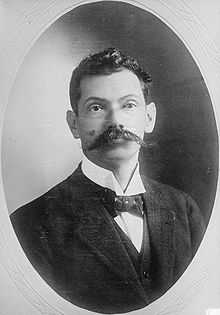Francisco Bertrand
Francisco Bertrand Barahona (born October 9, 1866 in Juticalpa, Olancho, † July 15, 1926 in La Ceiba ) was three times President of Honduras .
Life
His parents were Josefa Barahona and Pedro Bertrand. He married Victoria Alvarado Buchard. He was a member of the Partido Nacional de Honduras . Beltrand was a doctor of medicine and surgery . He was a MP for Olancho and was named Deputy President in 1904.
He became president through the US intervention in Honduras in 1911 . In the first term of office, Bertrand had the reputation of a mediator. In October 1911, presidential elections for the 1912-1916 term were held. The winner was Manuel Bonilla , and his deputy was Francisco Bográn Barahona. A few days before taking office, Francisco Bográn Barahona submitted his resignation on January 22, 1912.
Francisco Bertrand Barahona became Vice President. On March 20, 1913, Manuel Bonilla fell seriously ill and handed over the presidency to Francisco Bertand Barahona.
In October 1915 Francisco Bertrand received the highest number of votes in the presidential elections, his deputy was Alberto Membreño Vásquez. On February 1, 1916, Francisco Bertrand took up his presidency and the Diocese of Honduras was upgraded to an Archdiocese .
First World War
On January 19, 1917, the German government issued a Zimmermann dispatch requesting the government of Venustiano Carranza in Mexico to attack the United States. On April 6, 1917, the USA declared war on the German Reich.
In 1917 there were differences over the amount of taxes the United Fruit Company had to pay to the Honduran state. The United Fruit Company used its extensive transport monopoly and stopped freight traffic to and from Honduras for eight months. After eight months, the government of Bertrand assured to no longer charge the UFCO with taxes and duties.
During this tenure, a road that Terencio Sierra had begun was extended from Támara to Comayagua. A large part of the official seat and the Central de Telégrafos building were built. On July 19, 1918, the government of Francisco Bertrand declared war on the government of the German Empire .
1919 civil war
A law of April 4, 1919 proclaimed presidential elections. The dismissal of the candidate of the Partido Nacional de Honduras , Nazario Soriano, a brother-in-law of Bertrand, increased the opposition to Bertrand. Bertrand had his deputy, Alberto Membreño Vásquez, arrested in July 1919. A group around General Rafael López Gutierrez waged civil war in Honduras in July and August 1919. The insurgents included: Generals Vicente Tosta, Greogrio Ferrera and J. Ernesto Alvarado. Francisco Bertrand declared a state of emergency on the big cities. The US government called for civil rights to be respected. On September 9, 1919, Bertrand gave up his presidency to his cabinet and left Honduras via Amapala on the steamer USS San José for the USA.
Government cabinet
- Salvador Aguirre, Government Minister,
- Jesús Bendaña, Foreign Minister,
- Leopoldo Córdova, Minister of Finance,
- Santiago Meza Cálix, Minister of War and the Navy,
- Federico Smith Vanegas, Secretary of Public Relations,
- Hector Valenzuela, Minister of Education, Public Works Agriculture.
these ministers resigned on September 16, 1919.
A new government cabinet was then formed:
- Vicente Mejía Colindres, Minister of Government,
- Jesús M. Alvarado, Foreign Minister,
- Antonio Bermúdez, Minister of Finance,
- Remigio Díaz Zelaya,
- Santiago Meza Cálix
- Vicente Tosta Carrasco.
This Council of Ministers called on Vice-President Alberto Membreño, who had exiled to Guatemala after his imprisonment, to take office. This refused for health reasons.
It is believed that pressure from the United States government under Woodrow Wilson was the cause of Francisco Bertrand's premature transfer of the presidency. On September 14, 1919, insurgents from El Salvador against General Teófilo Cárcamo captured La Esperanza, the capital of the Intibucá department . US Ambassador Thomas Sambola Jones (1859-1933) instructed the insurgents to unite in Tegucigalpa under the command of General Rafael López Gutiérrez .
Francisco Bertrand returned to Honduras in June 1926 and settled in La Ceiba.
Web links
Individual evidence
- ^ New York Times March 5, 1911, HONDURAN FACTIONS AGREE , Francisco Bertrand Chosen President Pending Election to Replace Davila
- ^ New York Times April 24, 1917 GERMAN PLOT BARED IN CENTRAL AMERICA Teutons and Carranzistas Conspired to Start Revolts in Five Republics
- ↑ Hannes Bahrmann Piraten der Karibik Military Publishing House of the GDR Berlin 1990. p. 209
- ^ New York Times Jul 23, 1918 HONDURAS DECLARES WAR Secretary Lansing was formally notified today of the declaration of war by Honduras against Germany.
- ^ New York Times , October 8, 1919, TOSTA BACKS GUTIERREZ Dr. Membreno was imprisoned by President Bertrand in July
- ↑ Amapala
- ^ New York Times , September 11, 1919, PRESIDENT FORCED TO QUIT HONDURAS Dr. Membreno was imprisoned by President Bertrand in July
- ↑ United States Ambassador to Honduras
- ^ New York Times September 16, 1919 HONDURAN REBELS 'VICTORY; Occupy La Esperanza Pursuing the Ex-President's Forces
| predecessor | Office | successor |
|---|---|---|
| Miguel R. Dávila |
President of Honduras March 28, 1911 to February 1, 1912 |
Manuel Bonilla |
| predecessor | Office | successor |
|---|---|---|
| Manuel Bonilla |
President of Honduras March 21, 1913 to July 28, 1915 |
Alberto Membreño Vásquez |
| predecessor | Office | successor |
|---|---|---|
| Alberto Membreño Vásquez |
President of Honduras February 1, 1916 to September 9, 1919 |
cabinet |
| personal data | |
|---|---|
| SURNAME | Bertrand, Francisco |
| ALTERNATIVE NAMES | Bertrand Barahona, Francisco |
| BRIEF DESCRIPTION | Honduran President (1911-1912 / 1913-1915) |
| DATE OF BIRTH | October 9, 1866 |
| PLACE OF BIRTH | Juticalpa, Olancho, Honduras |
| DATE OF DEATH | July 15, 1926 |
| Place of death | La Ceiba |
